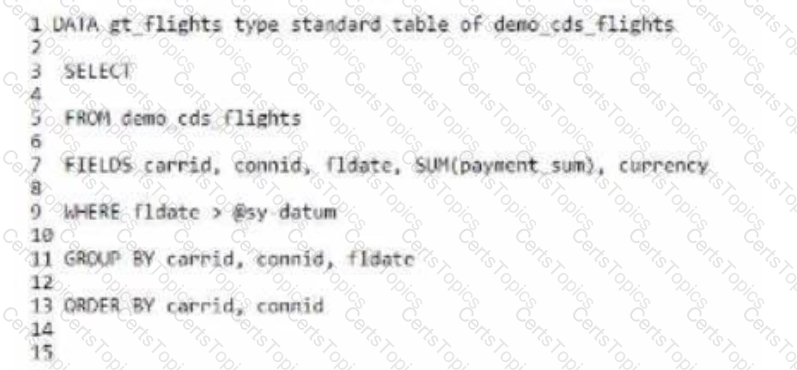Given the Code:
INTERFACE if1.
METHODS m1.
ENDINTERFACE.
CLASS cl1 DEFINITION.
...
INTERFACES if1.
ENDCLASS.
CLASS cl2 DEFINITION.
...
DATA mo_if1 TYPE REF TO if1.
ENDCLASS.
What are valid statements? (Note: There are 3 correct answers to this question.)
You are given the following information:

1.
The data source "spfli" on line #2 is an SAP HANA
database table
2.
"spfli" will be a large table with over one million rows.
3.
This program is the only one in the system that accesses
the table.
4.
This program will run rarely.
Based on this information, which of the following general
settings should you set for the spfli database table? Note:
There are 2 correct answers to this question.
Which ABAP SQL clause allows the use of inline declarations?
when you attempt to activate the definition, what will be the response?
What are advantages of using a field symbol for internal table row access? Note: There are answers to this question.
In ABAP SQL, which of the following can be assigned an alias? Note: There are 2 correct answers to this question.
When does SAP recommend to use a sorted or a hashed table respectively? Note: There are 2 correct answers to this question.
You have two internal tables itab1 and itab2.What is true for using the expression itab1 = corresponding #( itab2 )? Note: There are 2 correct answers to this question.
What are some features of a unique secondary key? Note: There are 2 correct answers to this question.
Using ABAP SQL, which select statement selects the mat field on line #17?
In the assignment, data (gv_result) = 1/8. what will be the data type of gv_result?
You are designing the following select statement in ABAP Open SQL:

To adhere to the most recent ABAP SQL syntax conventions from SAP, on which line must you insert the "INTO TABLE @gt flights" clause to complete the SQL statement?
Which extensibility type does SAP recommend you use to enhance the existing UI for an SAP Fiori app?
What RESTful Application Programming object contains only the fields required for a particular app?
Exhibit:
DEFINE TABLE demo_table {
KEY field1 : REFERENCE TO abap.cint(3);
KEY field2 : abap.char(133);
@Semantics.quantity.unitOfMeasure : 'demo_table.field4'
field3 : abap.quan(2);
field4 : abap.unit(2);
}
Which field is defined incorrectly?
You want to provide a short description of the data definition for developers that will be attached to the database view

Which of the following annotations would do this if you inserted it on line #27
Which of the following are features of Core Data Services? Note: There are 3 correct answers to this question.
In a test method you call method cl_abap_unit_assert=>assert_equals( .. ) in the following way:
CLASS Itcl1 DEFINITION FOR TESTING RISK LEVEL HARMLESS DURATION SHORT.
PRIVATE SECTION.
METHODS m1 FOR TESTING.
ENDCLASS.
CLASS Itcl1 IMPLEMENTATION.
METHOD m1.
DATA: go_test_object TYPE REF TO zcl_to_be_tested.
CONSTANTS: Ico_exp TYPE string VALUE 'test2'.
CREATE OBJECT go_test_object.
cl_abap_unit_assert=>assert_equals(
EXPORTING
act = go_class->mv_attribute
exp = lco_exp
msg = 'assert equals failed ' && go_test_object->mv_attribute && ' ' && lco_exp
ENDMETHOD.
ENDCLASS.
What will happen if method parameters act and exp are not equal?
In what order are objects created to generate a RESTful Application Programming application?
In RESTful Application Programming, which EML statement retrieves an object?
/DMO/I_Connection is a CDS view.
What variable type is connection full based on the following code? DATA connection full TYPE
/DMD/I_Connection.
In a subclass subl you want to redefine a component of a superclass superl. How do you achieve this? Note: There are 2 correct answers to this question.
What are some characteristics of secondary keys for internal tables? Note: There are 3 correct answers to this question.